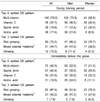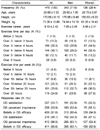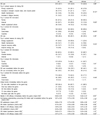Introduction
Intake of dietary supplementation (DS) in elite athletes is very common in many countries. Forty-five to 74 percent of Olympic athletes [
1-
5], 53 to 95 percent of winter sports athletes [
3,
4], and 69 to 95 percent of summer sports athletes [
2,
6] took various DS in order to cure minor illness, supply energy, boost energy use, maintain health, and increase immune function for preventing illness. They also took DS to increase strength, muscle power, muscle mass, endurance performance, and recovery ability. Moreover, over 80 percent of Korean Olympic athletes took DS to increase muscle performance, improve recovery ability, maintain health, or prevent nutritional deficiency. Unlike Western athletes, it was reported that about 58 percent of Korean athletes also take oriental supplements (OS), such as traditional herbs, animal extracts from snakes, and gall bladder of bears, dogs, soft shell turtles, and black goats [
7]. Previous studies [
7-
9] have reported DS and OS use by Korean elite athletes; however, there is little information on DS and OS use during the training period and before the game, or on gender differences in DS and OS use.
National Complementary and Alternative Medicine Use Survey in 2006 (2006 NCAMUS) [
10] recently reported that 62 percent of 3,000 Korean adults (aged 30 - 69 years) take DS, of which the top five were ginseng (23%), multivitamins (14%), glucosamin (10%), probiotics (10%), and vitamin C (9%). This survey showed quite different results compared to recently reported studies. Professional elite athletes' DS use [
11] and adolescent elite athletes' DS use [
9] study showed that athletes mostly took oriental supplements and ergogenic aids. Moreover, H. Kim and Keen [
12] reported that adolescent elite athletes show higher vitamin use than NCAMUS' report [
10], and this implies that there may be a difference between elite athletes' and non-elite athletes' DS use. In addition, J. Kim and colleagues [
9] reported that there is a relationship between DS use and anti-doping awareness in male adolescent elite athletes, as well as a gender difference; however, they did not consider anti-doping education and environmental factors such as training and the game period that could cause an unclear relationship between anti-doping awareness and DS use. Further, Chun et al. [
11] reported that DS use by elite athletes is related with anti-doping education, and athletes educated about anti-doping use DS 80% more frequently compared to non-experienced doping education athletes; however, they did not consider gender, OS use, or doping education experience time.
Anti-doping awareness can be increased by anti-doping education. To improve anti-doping awareness, Korean elite athletes have received compulsory education since 2007. Anti-doping education is conducted one time per year upon request by sports event cities and province associations, national representative teams, professional physical education high schools, and national sports universities. Before an international game, all Korean athletes should receive compulsory anti-doping education. However, compared to sports advanced nations, such as the USA (1982) and Japan (2001) (Unpublished), Korea has little experience in periodical and compulsory anti-doping education. This fact may affect Korean athletes' anti-doping awareness. Moreover, it was reported that DS use can be increased by 77% under high anti-doping awareness status [
7], which implies that anti-doping education may be very much important for enhancing athletes' anti-doping knowledge and awareness. DS use directly increases with age, along with expensive DS patterns [
7]. According to previous studies, it is expected that there would be differences in DS use and anti-doping awareness between adolescent elite athletes [
9] and elite athletes [
11].
Although it is recognized that anti-doping education is practically important and needed for athletes and coaches, the relationship between anti-doping education and DS use remains unclear. Therefore, the purpose of this study was to investigate relationships between DS and OS use during the training and game periods, anti-doping education, gender differences in anti-doping knowledge, and awareness and anti-doping education. Our study results provide useful information for coaches and families and make athletes actively participate in doping education.
Results
Four hundred and seventy-nine university athletes (male = 343, female = 136) participated in this study. Archery (n = 14), badminton (n = 18), bowling (n = 13), boxing (n = 23), canoe (n = 19), cycling (n = 8), gymnastics (n = 23), handball (n = 27), hockey (n = 34), Judo (n = 36), modern pentathlon (n = 11), rowing (n = 16), skating (n = 16), shooting (n = 29), swimming (n = 24), Taekwondo (n = 35), tennis (n = 9), throw (n = 17), track (n = 48), weightlifting (n = 24), and wrestling (n = 35) athletes participated in this study. Mean exercise time per day was 3-5 hours, accounting for over 60% of the total response, and there were no statistical differences according to gender. Mean exercise time per week was longer than 16 hours, accounting for over 80% of the total response, and no differences according to gender were detected (
Table 1).
DS and OS use during training period
DS and OS practices based on gender during the training period are presented in
Table 2. Forty-six percent of athletes used DS during the training period, and there was significantly higher DS use by female athletes (53%) than males (43%) (
P < 0.05). Twenty-eight percent of athletes used OS, and there was significantly higher OS use in female athletes (35%) than males (26%) (
P < 0.05). The primary reason for DS use was to supply energy in both male (36%) and female (28%) athletes.
Moreover, reasons for prevalent DS use showed significant gender differences (P < 0.05). Reasons for male athletes' DS use were energy supplementation (36%) and increasing strength, muscle mass, and muscle power (21%). Reasons for female athletes' DS use were energy supplementation (28%) and health maintenance (22%) (P = 0.01).
The main reason for male athletes' OS use was to supply energy (41%). Meanwhile, reasons for female athletes' OS use were to supply energy (23%), maintain health (19%), and improve recovery ability (20%), and these were significantly different according to gender (P < 0.05). Family (31%) and Internet (30%) were the most often identified sources of DS information used by male athletes while family (50%) was the main source for female athletes, which showed a significant gender difference (P < 0.05). The most often identified source of OS information was family for both genders, with no gender difference. Male athletes' DS informants were family (59%) and teammates (24%) while female athletes' DS informants were family (81%), which constituted a significant gender difference (P < 0.05). OS informants were family (84%), coaches (7%), and teammates (2%) for both genders, and there was no significant gender difference. DS and OS satisfaction, perceived importance, and beliefs in efficacy during the training period were all over average (over 50 mm), and there was no significant difference according to gender.
Table 3 shows dietary supplementation practice during the training period according to gender. During the training period, the top four ranked DS patterns were multi-vitamin (70%), vitamin C (38%), sports drink (18%), and amino acid (17%), whereas the top three ranked OS patterns were red ginseng (70%), mixed oriental medicine (45%), and ginseng (11%). DS and OS intake trends during the training period were similar between male and female athletes. The top four ranked DS patterns immediately before the game were multi-vitamin (46%), sports drink (42%), vitamin C (32%), and amino acid (20%), and this showed similar trends in gender. The top three ranked OS patterns immediately before the game were red ginseng (67%), mixed oriental medicine (40%), and ginseng (8%), and this also showed similar trends according to gender.
DS use immediately before the game
Dietary supplementation practice immediately before the game according to differences according to gender is shown in
Table 2. DS use immediately before the game occurred in 41% of all participants, and there was no significant difference according to gender. DS informants immediately before the game were family (52%) and coaches (19%) for males and family (72%) for females, which constituted a significant difference according to gender. Female athletes' DS use immediately before the game occurred at 30 min after breakfast on game day. Male athletes showed higher response rates for DS use 1 hour and 30 min immediately before the game as compared to females, which was significantly different (
P < 0.05). Belief in DS efficacy immediately before the game and knowledge of anti-doping were higher in males than females; however, there was no significant difference according to gender (see
Table 2).
Knowledge and awareness in doping education
The rate of doping education in all participants was 76% in this study (see
Table 4). Periodical doping education experience was one time (66%), two times (24%), and over three times (10%) per year, and there was no significant difference according to gender. Athletes responded that the most effective doping education method was periodical anti-doping education provided by the Korea anti-doping agency (KADA) (71%). They also responded effective doping education method as follows: regular education by coaches immediately before the game (40%), periodical education by coaches (33%), anti-doping guidelines provided by the KADA (27%), and the Internet (25%). Anti-doping informants were more frequently found in the KADA (43%) and in coaches (41%), and there was no significant difference according to gender. Understanding of the guidelines provided by the KADA and doping knowledge was above average (over 50 mm) for both genders.
Relationship in doping education and DS use
Fig. 1 shows the relationship between doping education and DS and OS use during the training period and before the game. In a comparison of doping education between experienced athletes (at least over one time) and non-experienced athletes, DS and OS use during the training period was 2.30 (1.47-3.60) and 1.71 (1.03-2.82), respectively. DS and OS use immediately before the game was 2.38 (1.50-3.80) and 3.99 (1.20-13.28), respectively.
Regarding the rate of doping education, DS use during the training period was as follows: one time 2.67 (1.66-4.29), two times 2.97 (1.64-5.37), and more than three times 0.32 (0.11-0.91). OS use during training was one time 2.0 (1.18-3.38), two times 1.83 (0.96-3.49), and more than three times 0.21 (0.05-0.94).
Regarding the rate of doping education, DS use immediately before the game was as follows: one time 2.60 (1.59-4.23), two times 3.42 (1.88-6.23), and more than three times 0.35 (0.11-1.07). OS use immediately before the game was one time 3.66 (1.07-12.56), two times 6.44 (1.74-23.81), and more than three times 1.12 (0.11-11.17) (see
Fig. 2).
Discussion
The data show that DS and OS use by Korean elite university athletes was 46% and 28%, respectively. The data demonstrate that female athletes used DS and OS significantly more compared to males. Seventy-six percent of all participants experienced doping education in the past year, and there were strong associations among doping education and DS and OS use during training and immediately before the game period.
Most previous studies have reported that elite athletes' DS use during training is between 45-95% [
1-
6]. Sundgot-Borgen et al. [
4] and Erdman et al. [
21] reported that no difference in DS use in elite athletes during training period, which is in contrast with our present study. Further, previous studies did not clearly explain the reason for gender differences in DS use, which makes a comparison with our study results impossible. Nevertheless, there were gender differences in reasons for DS use, DS use information, and DS use informants. This finding may imply that gender is the main reason for the differences in DS use. Regarding OS use during the training period, there were no differences in OS use information and informants. However, only the reasons for OS use displayed gender differences. These data suggest that gender primarily affected DS and OS use as opposed to information and informants. Moreover, Kim et al. [
7] reported that the Korean national team participating at the 29
th Beijing Olympic games displayed no gender differences in DS and OS use or reasons for DS use during training and immediately before the game period, which was in agreement with our study.
Until now, elite athletes' DS use immediately before and after the game has only been reported in Olympic athletes [
1-
3,
7]. Our data show that DS and OS use by elite university athletes immediately before the game was 41% and 19%, respectively, which is higher than Olympic athletes' DS use (14%) reported by Kim et al. [
7]. Our study participants' mean age was 20.9 years, which is younger than Olympic athletes' mean age. Younger age might result in higher DS and OS use immediately before the game. In addition, our study results show that DS use immediately before the game was higher in younger age athletes. We also verified DS use time trend, and found that 64% of athletes in this study used DS 30 min after breakfast. However, we cannot explain this intake trend since there are no similar reports. We generally assumed that the highest DS use trend on game day in the morning might have been due to family recommendation. Previous studies reported that DS use immediately before the game mostly was the result of family as informants [
4,
6,
7]. In accordance with this result, our study found that family was the main reason for DS and OS use by male and female athletes during training period and immediately before the game.
It is considered that DS or OS use immediately before the game might be related to doping. Our data show that understanding of anti-doping with DS use immediately before the game was 59.1 mm while belief in DS efficacy immediately before the game was 69 mm. These results were higher compared to those for belief in DS (58.4 mm) and OS (54.7 mm) during the training period, which ensures that athletes believed in the benefits of DS and OS use. Moreover, satisfaction and importance of DS and OS use during the training period were above average in both males and females with no differences according to gender, which suggests that positive attitudes toward DS and OS use. Consequently, athletes' satisfaction, perceived importance, and belief in efficacy of DS and OS use may be related to the reasons for DS and OS intake. We assumed that no changes in athletes' satisfaction, perceived importance, and belief in efficacy of DS and OS use might cause any gender differences, even though they had different DS and OS use reasons.
The patterns of DS and OS use during the training period were mainly in the forms of multi-vitamin (70%) and red ginseng (70%) both for males and females. Based on previous studies, it was reported that elite athletes mainly consumed DS in the forms of multi-vitamin and vitamin C [
2-
4,
6,
7,
9,
12,
17,
21]. The importance of vitamin intake was reported to increase athletic performance among DS intake reasons [
22]; however, vitamin was not reported in a strict double blinded test concerning practical performance. DS and OS intake patterns during the training period were in accordance with DS and OS intake patterns immediately before the game. Therefore, future study would be needed to examine elite athletes' DS intake for increasing athletic performance.
The interesting finding of this study is that doping education was found to be related to DS and OS use during the training period and immediately before the game. Specially, anti-doping education seemed to increase DS and OS use during the training period and immediately before the game, which proved anti-doping education was directly related to elite athletes' proper DS use. Our data suggest that periodical anti-doping education was the most effective way to prevent doping issues. Further, our data reveal that understanding the guidelines provided by the KADA (57.6 mm), anti-doping knowledge (52.9 mm), and anti-doping education importance (71.3 mm).In agreement with our study, Kim and colleagues [
9] reported that doping education caused increased DS intake in junior athletes throughout the training period, and similar results were shown in adult elite athletes [
11]. This result ensures that anti-doping education is important for proper DS use. DS and OS use during training and immediately before the game period increased as anti-doping education frequency was increased; however, we found that elite athletes who experienced anti-doping education more than three times experienced decreased DS and OS intake, which was very unique. This previously unreported result clearly explained the association between anti-doping education and DS use. In Korea, most anti-doping education is conducted before high-level competitions by the KADA. Elite athletes who experienced anti-doping education more than three times mostly participate in high-level competition games. Therefore, they may think of DS and OS intake and this might be a possible reason to decrease DS and OS use. Future studies need to more clearly determine the reasons for DS use and verify the relationship between anti-doping education time, athletes' performance levels, and doping knowledge followed by education, doping awareness, and DS use.
In conclusion, elite athletes' anti-doping education is highly related to increased DS use during the training period and immediately before the game. Korean elite university athletes showed higher OS use compared to Western athletes. Therefore, safe supplement recommendations are needed by athletes.







 PDF
PDF ePub
ePub Citation
Citation Print
Print





 XML Download
XML Download